Electrostatic Levitation Furnace – ELF
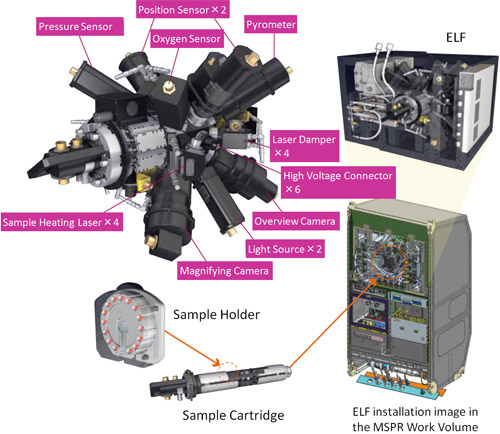
The Electrostatic Levitation Furnace will provide ISS with its second Materials Science facility operating on the basis of electrostatic levitation, alongside the Electromagnetic Levitator that is active aboard the Columbus laboratory, studying fundamental principles of metallurgy. Heating and melting samples of metal alloys or other materials in a zero-G environment followed by the solidification of the sample yields a very pure material without any contaminations. The study of the solidification process and the finished product can provide valuable knowledge concerning the properties of the material that could improve production techniques on Earth for better material properties in alloys, glass and ceramics.
The ELF facility is operated within the Multi-Purpose Small Payload Rack rack inside the Kibo module, supplied with ISS power, data connectivity and gas. The payload has a total mass of 220 Kilograms and is 59 by 88.7 by 78.7 centimeters in dimensions with an additional UV Lamp module that measures 22.6 by 25.9 by 34.7 centimeters. Major components of ELF are the sample delivery and accommodation system, a sample heating laser system, a suite of sensors including position sensors, oxygen and pressure sensors, a pyrometer, plus two cameras, light sources and support electronics.
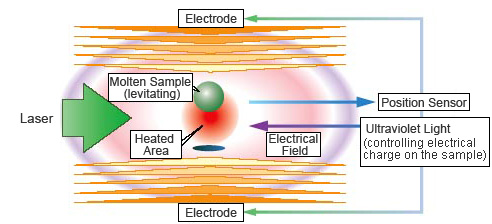
The primary purpose of the ELF payload is to provide containerless melting and solidification of a variety of samples in a controlled environment to study material properties – providing knowledge needed for the improvement of production techniques for metal alloys, ceramics or different types of glass, among other materials.
A spherical sample with a diameter of 1.5 to 5 millimeters is delivered into the ELF chamber by a sample cartridge that receives samples from a holder containing a number of samples so that prolonged ground-controlled operation of the facility is possible and crew members only have to periodically change out the sample holder.
Within ELF, samples are held in place by Coulomb forces between a charged sample and surrounding electrodes that are biased by a controller that receives real time data from a pair of position sensors to keep the sample floating freely in a small corridor within the experiment chamber. This method of sample levitation in a closed-loop sensor-actuator feedback design allows the payload to accept different samples such as metal, ceramics, glass, and liquids.
The positioning system operates at a control period of 1kHz meaning that 1,000 position sensor inputs are processed per second to send up to 1,000 bias commands to the electrodes that operate at a maximum voltage of 3,000 Volts. Overall, the positioning system achieves an sample positioning accuracy of +/-300 micrometers.
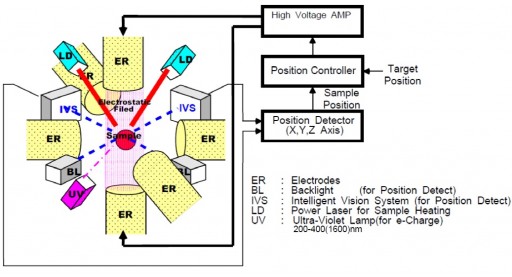
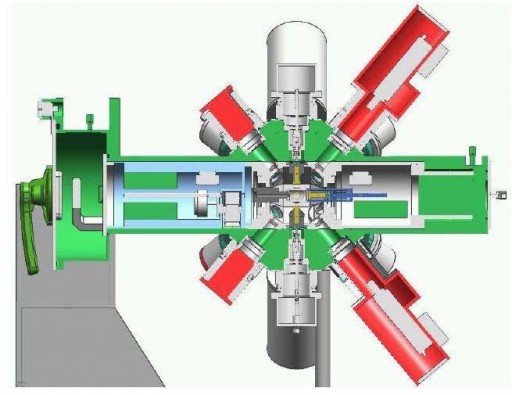
Heating of the sample is provided by a set of four lasers, in contrast to the Electromagnetic Levitator that makes use of an electromagnetic field and induced Eddy currents leading to heating of the sample. ELF’s four lasers are arranged to uniformly heat up a sample to a temperature of over 2,000 °C. The infrared semiconductor lasers operate at a wavelength of 980 nanometers and each has a power output of 40 Watts. The maximum temperature achieved by the system is targeted to exceed the melting point of Zirconia at 2,710 °C. Sample baking can also supported by the ELF payload with temperatures of up to 1,300°C being reached in a matter of seconds.
Temperature measurements can be made by an infrared thermometer that has an operational range of 300 to 3000°C, covering the entire operational temperature range of ELF. To observe the material during the heating/melting and cooling/solidification process, ELF includes three sensors – a pyrometer and two cameras.
The highly sensitive digital pyrometer observes the sample to provide a high-resolution thermal image of the material to collect information on thermal gradients across the sample surface. It has a field of view of 5.7 by 4.3 millimeters, requiring the sample to be kept in a precise position to enable full-surface measurements during the entire experiment process. The pyrometer hosts an Indium-Gallium-Arsenide detector sensitive at wavelengths of 1.45 to 1.80 micrometers, operating at a sampling frequency of 100 Hz.
The two cameras are the Magnifying Camera primarily used for density measurements and the Overview Camera that provides video of the solidification process. The Magnifying Camera has a resolution of 640 by 480 pixels corresponding to a field of view of 19 by 14 millimeters in the fully zoomed-out mode and 2.4 by 1.8 millimeters when fully zoomed in. The Overview Camera has a wide dynamic range and covers a field of view of 24 by 18 to 3.0 by 2.4 millimeters on a 640 by 480-pixel CCD detector. It collects 30 images per second. Illumination of a sample (if not self luminous) is provided by a UV-LED.
To keep the sample at a specified charge, ELF uses the photoelectric effect. A Deuterium Lamp with a power of 30 Watts delivers UV radiation required to keep the sample within the required charge range.
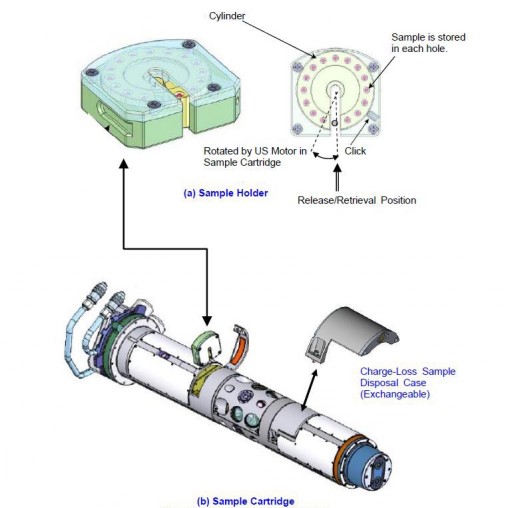
For measurements of surface tension and viscosity of a sample at different temperatures, ELF utilizes a vibration excitation that can be varied from 1 to 600 Hz while a voltage excitation for conducting materials is also available and can be set from -3kV to +3kV.
The ELF experiments can be run in different environments to allow the facility to conduct a variety of studies. The major variable for experiments is the environment inside the chamber that can be varied from a high-quality vacuum to a number of gas compositions. Available gas combinations for ELF are ISS supply gas (99.99% Nitrogen by volume), Argon supplied by Kibo’s unique systems, or standard air at any pressure up to 2 bar.
The operational requirements for the crew are kept low by the ELF concept, only requiring crew members for the initial setup and periodic maintenance of the payload as well as the exchange of the sample holder that facilitates up to 15 samples. The samples are automatically removed from the holder and released into the sample cartridge where samples are directed into the experiment chamber. After the run is complete, the processed sample is moved back to the holder and the next sample can be inserted by the ground commanding the motor within the holder to rotate the next sample into the cartridge. Once all samples have been processed, the holder can be returned to the ground for detailed analysis of the samples.
